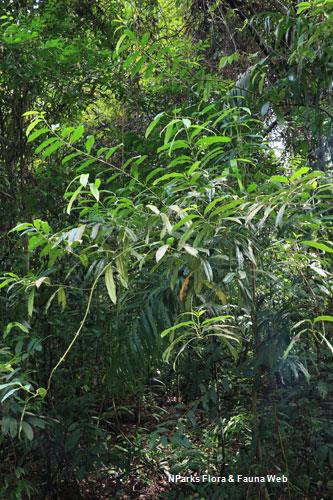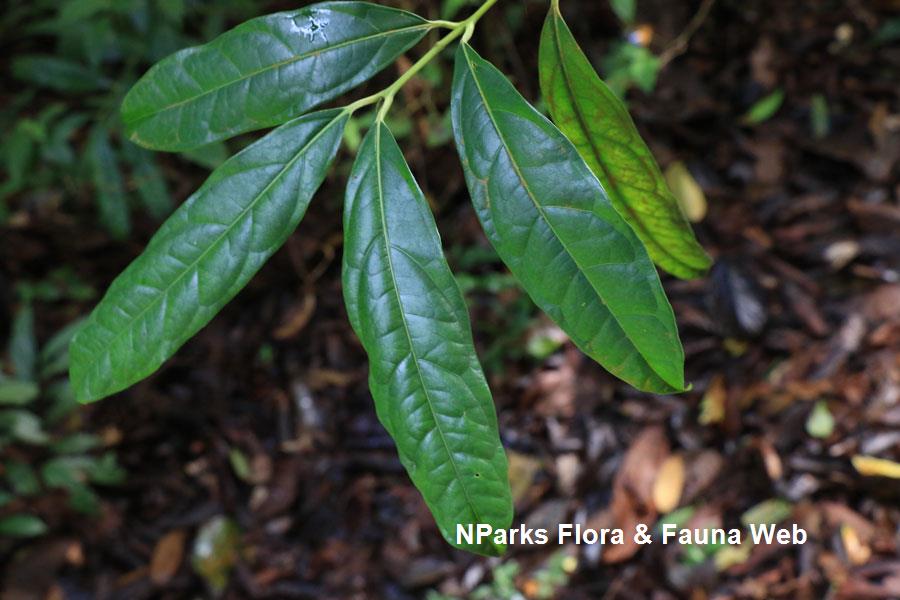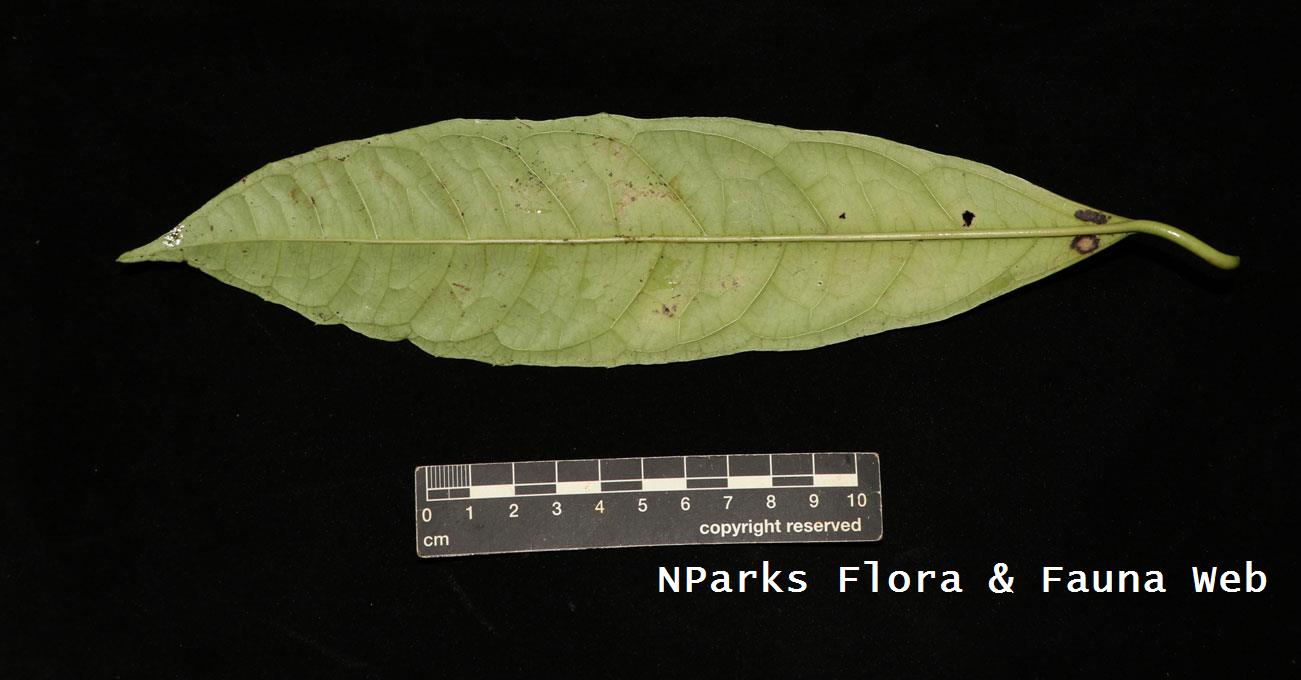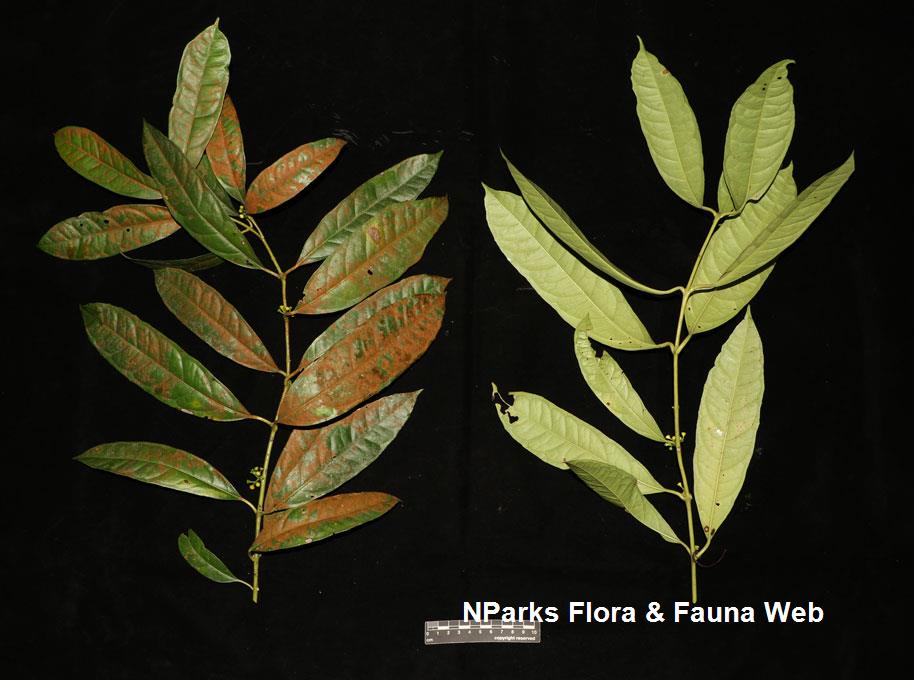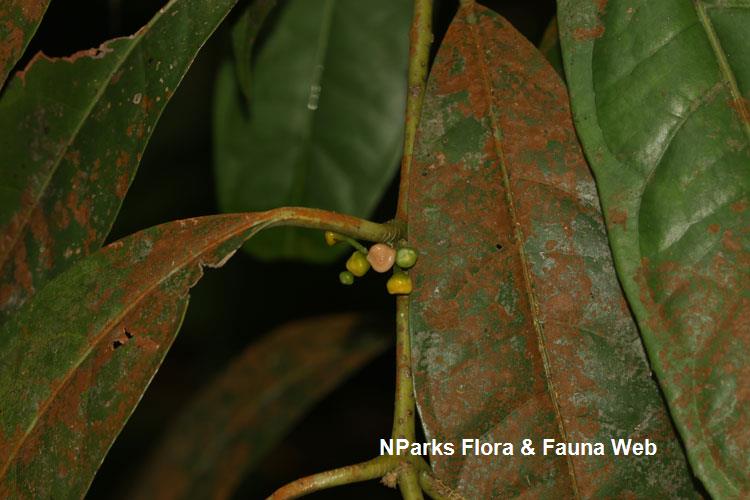
Back
Matthaea sancta Blume
| Family Name: | Monimiaceae |
| Common Name: | Pokok Cherum |
Mathaea sancta or Pokok Cherum is a shrub or small tree native to Singapore. Typically growing to a height of 3 - 4m tall, it produces leathery, lanceolate-oblong to oblong leaves with looping margins that are prominent below. Flowers are monoecious, green, pale yellow to yellow coloured, produced singly or in an inflorescence along the axils. The fruit is a leathery, elliptic or egg-shaped drupelet, often in clusters of up to 16, turns purple-black or blue-black upon maturity.
Name
Classifications and Characteristics
| Plant Division | Angiosperms (Flowering Seed Plants) (Dicotyledon) |
|---|---|
| Plant Growth Form | Shrub, Tree (Small (6m-15m)) |
| Maximum Height | 6 m |
Biogeography
| Native Distribution | Peninsular Malaysia, Sumatra, Anambas Island, Borneo, Philippines, Celebes and Singapore. |
|---|---|
| Native Habitat | Terrestrial (Primary Rainforest, Secondary Rainforest) |
| Preferred Climate Zone | Tropical |
| Local Conservation Status | Native to Singapore (Endangered (EN)) |
Description and Ethnobotany
| Growth Form | It is a shrub to small tree with smooth, pale brown outer bark. It grows between 3 - 6 m in height, rarely to 15 m tall. |
|---|---|
| Foliage | The leaves are leathery, lanceolate-oblong to oblong, measuring 14 - 32 cm long by 3 - 8.5 cm wide. Leaves are smooth above, sparsely hairy to almost smooth below. Leaf margins have varying degrees of serration, the midrib is flattened above, raised below while the veins are arched, ascending, looping near the margin, sunken above, prominent below. |
| Flowers | Flowers are monoecious where the male and female flowers are borne on the same tree. The flowers are produced singly or held on an inflorescence at the axils, bearing a terminal flower and 1 - 2 pairs of flowers on the lateral branch, each with 4 tepals. Male flowers have a round base, 4 - 5 mm wide while the female flowers have a turbinate-like base, measuring 10 -14 mm wide, green to pale yellow or yellow coloured. |
| Fruit | The fruit is a leathery, elliptic or egg-shaped drupelet which turns purple-black or blue-black upon maturity. Each drupelet measures 1.5 - 2.7 cm long and 0.8 - 1.8 cm wide, held on in clusters of up to 16. |
| Habitat | Occurs in primary lowland forest, in open or secondary forest at altitude of 100 - 150 m, or on hill sides up to 1000m altitude. <1 &2 > |
| Cultivation | It can be propagated by seed. |
| Ethnobotanical Uses | Timber & Products: The wood is heavy and branches are used to build houses. |
Plant Care and Propagation
| Light Preference | Semi-Shade |
|---|---|
| Water Preference | Moderate Water |
| Plant Growth Rate | Slow |
| Rootzone Tolerance | Well-Drained Soils, Moist Soils |
| Propagation Method | Seed |
Foliar
| Foliage Retention | Evergreen |
|---|---|
| Foliar Type | Simple / Unifoliate |
| Foliar Arrangement Along Stem | Opposite |
| Foliar Attachment to Stem | Petiolate |
| Foliar Shape(s) | Non-Palm Foliage (Lanceolate, Oblong) |
| Foliar Venation | Recticulate |
| Foliar Margin | Entire, Serrate / Toothed |
| Foliar Apex - Tip | Acuminate |
| Foliar Base | Cuneate |
Floral (Angiosperm)
| Flower & Plant Sexuality | Unisexual Flowers , Monoecious |
| Flower Colour(s) | Yellow / Golden, Cream / Off-White, Green |
|---|
| Flower Grouping | Cluster / Inflorescence |
| Flower Location | Axillary |
| Flower Symmetry | Radial |
| Inflorescence Type | Cyme |
| Flowering Habit | Polycarpic |
Fruit, Seed and Spore
| Mature Fruit Colour(s) | Black, Blue, Purple |
|---|---|
| Fruit Classification | Simple Fruit |
| Fruit Type | Fleshy Fruit , Multiple Drupelet |
References
| References | <1> Philipson, W.R. (1986). Monimiacae. Flora Malesiana, ser. 1, Seed Plants, vol. 10, pt. 2, pp. 323-324. Leiden: Rjksherbarium. <2> Syahida-Emiza, S. (2017). Monimiaceae. Flora of Peninsular Malaysia, ser. 2, Seed Plants, vol. 6, pp. 32-34. Selangor: Forest Research Institute Malaysia. |
|---|
Image Repository
Others
| Master ID | 33815 |
|---|---|
| Species ID | 8231 |
| Flora Disclaimer | The information in this website has been compiled from reliable sources, such as reference works on medicinal plants. It is not a substitute for medical advice or treatment and NParks does not purport to provide any medical advice. Readers should always consult his/her physician before using or consuming a plant for medicinal purposes. |

